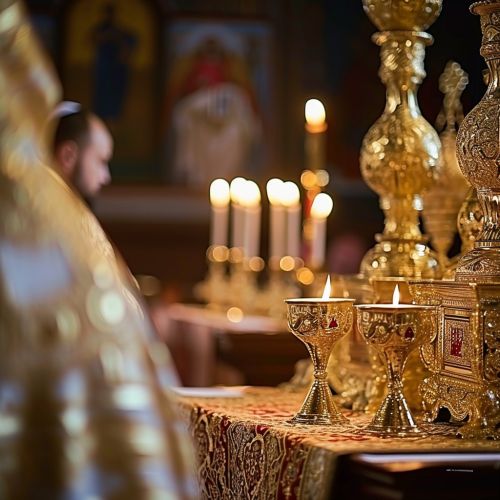Oriental Orthodoxy
Introduction
Oriental Orthodoxy is a communion of Christian churches that maintain their own distinctive theological and liturgical traditions, which are rooted in the teachings of the early Church. These churches are primarily located in the Middle East, Africa, and Asia, and have a combined membership of approximately 60 million believers worldwide.
History
Oriental Orthodoxy traces its origins to the apostolic era, with many of its constituent churches claiming apostolic succession through the apostles of Jesus Christ. The communion as a whole, however, was formally established in the 5th century following the Chalcedonian schism, when it separated from the larger body of the Christian Church over differences in Christological doctrine.
Pre-Chalcedonian Era
The churches that would eventually form the Oriental Orthodox communion were among the earliest Christian communities. They were established in regions such as Egypt, Syria, Armenia, and Ethiopia, often by apostles or their direct disciples. These early churches developed their own distinctive liturgical and theological traditions, many of which are still preserved today.
Chalcedonian Schism
The defining event in the history of Oriental Orthodoxy was the Council of Chalcedon in 451 AD. This council, convened by the Roman Emperor Marcian, was intended to resolve the Christological controversies that had arisen in the wake of the Council of Ephesus in 431. The council's definition of Christ's nature as being both fully divine and fully human in one person, known as the Chalcedonian Definition, was rejected by the churches that would go on to form the Oriental Orthodox communion. These churches, known as the "Non-Chalcedonian" or "Miaphysite" churches, maintained that Christ has one single nature that is both divine and human.
Post-Chalcedonian Era
Following the Chalcedonian schism, the Oriental Orthodox churches found themselves increasingly isolated from the larger Christian world. Despite this, they managed to preserve their distinctive traditions and even experienced periods of growth and expansion, particularly in Africa and Asia.
Theology
The theology of Oriental Orthodoxy is rooted in the teachings of the early Church, particularly the doctrines of the Trinity and the Incarnation. The communion's distinctive Christological doctrine, known as Miaphysitism, holds that Christ has one single nature that is both divine and human. This contrasts with the Chalcedonian Definition, which holds that Christ has two natures, one divine and one human, in one person.
Trinitarian Doctrine
Like all Christian churches, Oriental Orthodoxy affirms the doctrine of the Trinity, which holds that God is one being in three persons: the Father, the Son, and the Holy Spirit. This doctrine is foundational to Oriental Orthodox theology and is reflected in the communion's liturgy and spiritual practices.
Christological Doctrine
The distinctive Christological doctrine of Oriental Orthodoxy is known as Miaphysitism. This doctrine holds that in the person of Jesus Christ, the divine and human natures are united in one single nature without separation, confusion, alteration, or division. This contrasts with the Chalcedonian Definition, which holds that Christ has two natures, one divine and one human, in one person.
Sacraments
Oriental Orthodoxy recognizes seven sacraments: Baptism, Confirmation, Eucharist, Penance, Anointing of the Sick, Holy Orders, and Matrimony. These sacraments are seen as means of grace through which believers participate in the life of Christ.
Liturgy
The liturgical traditions of Oriental Orthodoxy are among the oldest and most distinctive in Christianity. Each of the communion's constituent churches has its own unique liturgical tradition, but all share a common emphasis on the sacraments, particularly the Eucharist, and the veneration of saints.

Eucharistic Liturgy
The Eucharistic liturgy, also known as the Divine Liturgy, is the center of worship in Oriental Orthodoxy. The liturgy is a reenactment of Christ's Last Supper, during which bread and wine are consecrated and distributed to the faithful as the body and blood of Christ.
Liturgy of the Hours
The Liturgy of the Hours, also known as the Divine Office, is a daily cycle of prayers that is observed by clergy and monastics in Oriental Orthodoxy. The office includes psalms, hymns, and readings from the Scriptures and the Church Fathers.
Veneration of Saints
The veneration of saints is a prominent feature of Oriental Orthodox liturgy. Saints are seen as models of Christian virtue and as intercessors who can aid the faithful in their spiritual journey.
Constituent Churches
The Oriental Orthodox communion is made up of six autocephalous churches: the Coptic Orthodox Church, the Syriac Orthodox Church, the Armenian Apostolic Church, the Ethiopian Orthodox Tewahedo Church, the Eritrean Orthodox Tewahedo Church, and the Malankara Orthodox Syrian Church. Each of these churches maintains its own distinctive traditions and is governed by its own patriarch or catholicos.
